Failure Is an Option: For Students at Iowa Big, Tests Come First, Learning From Experiences Follows
By Kate Stringer | June 7, 2019
Cedar Rapids, Iowa
She calls it her famous failure.
During junior year of high school, Kinzie Farmer wanted to host a TEDx talk in Cedar Rapids, Iowa. It was a project for her new school, Iowa BIG, where students learn through work they do with community partners. Farmer sent in her application, lined up a group of speakers, and started planning the event. When she didn’t hear back, she called TED and found out her application had been declined the day it was sent in.
“I was shattered,” Farmer said. At her old high school, Farmer was used to getting As and knowing how to play the “game” to succeed. This moment at Iowa BIG, she said, was her first experience with failure. She went to her teacher, Shawn Cornally, and told him they had to cancel the event, and tell all the speakers she had failed. But instead, Cornally told her they could host their own event. Bruised ego in hand, Farmer approached the speakers and asked if they’d be OK with a pivot. To her surprise, they were still eager to participate. Farmer planned her own event on the topic of inspiring young women to overcome barriers.
That moment turned out to be a gift, Farmer said, and it was one of many at Iowa BIG where Farmer would often be tossed into uncharted territory with the real possibility of failure hanging over her head during her high school career.
“By not having a linear path to an ‘A’ or a linear path to success, I am much more comfortable in the unknown,” Farmer said, who is now 21, about to graduate from Gonzaga University in Spokane, Washington, and already has a marketing job at a startup.
Farmer is among the first group of Iowa BIG alumni to graduate from college, a major moment for a startup school model aimed at rethinking how students are prepared for college and career. At Iowa BIG, students collaborate with local businesses and community partners to pursue passion projects for which they earn academic credit. The model intentionally lacks the structure of traditional high schools in the hopes of helping students learn 21st-century skills like collaboration, communication, and time management.
“That’s what we care most about because these are the skills that get you to college and career,” said Trace Pickering, executive director and co-founder of Iowa BIG. “They get you hired; they get you fired.”
The school, which just finished its sixth year, earned recognition and $1 million in grant funding from XQ in 2016, an organization co-founded by Laurene Powell Jobs and dedicated to reinventing high schools around the country.
BIG operates as a partnership between three districts schools in eastern Iowa, which oversee the operations, employ the faculty, and provide funding. Students in these district schools have the option to enroll in BIG, splitting their school day between their traditional high school and BIG’s campus. This year, 250 attended, though school leaders have ambitions to grow BIG to as many as 2,000 students.
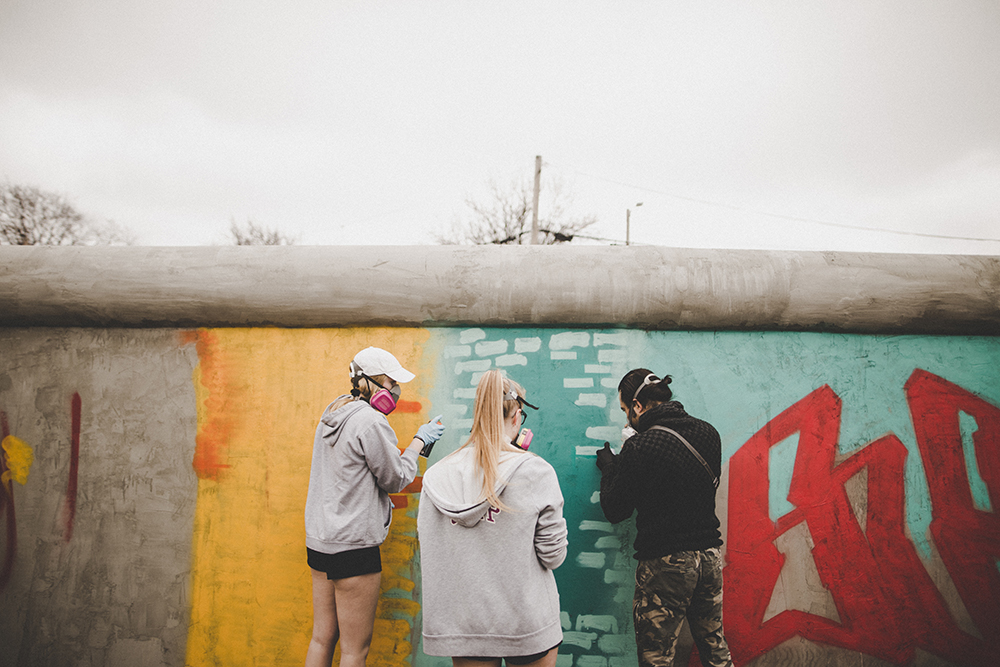
“At Iowa BIG, you get tested first and then you learn, and I argue that’s how the real world works,” senior Kellen Ochs said.
Learning from experiences like failure rather than learning from a textbook, is something students brought up repeatedly in their conversations about BIG. The students were not shy in sharing how frequently they messed up or didn’t accomplish what they thought they would in a project. Sometimes they discovered interests they didn’t knew they had (like marketing) or learned a topic they thought was their passion (like social studies) actually wasn’t.
And their teachers were not shy in offering critiques of student work, walking students through “retrospectives” or group meetings where they discussed how they struggled in a project and what they could have done better.
“Teenagers don’t ever get to iterate. Ever,” said Shawn Cornally, teacher and co-founder of Iowa BIG. “If they get a bad grade they move on. They don’t grow from it, they don’t try again.”
BIG tries to do the opposite of that, allowing students to make mistakes publicly, learn from them, and improve.
And in the process, the school leaders are also learning how to iterate on their own model, which started as a resistance to everything that is traditionally in a school — seat time, tests, letter grades, class periods. Over the years, they’ve been figuring out which of those structures they rejected are actually useful and which ones they still can do without.
The willingness of the Cedar Rapids community to participate and support the school model is critical to Iowa BIG’s success, as students need to be welcomed and trusted with real-world projects. Students said this experiential learning makes math or science more relevant and engaging because it’s connected with their lives.
“They are eager to come alive in a different way here that they don’t when working in schools,” said Kaitlin Byers, director of development at The New Bohemian Innovation Collaborative, a local business and Iowa BIG partner, which supports entrepreneurship and tech education. “When they’re making a difference in the community, that holds them accountable.”
A flood and a BIG idea
In a way, Iowa BIG wouldn’t exist if it weren’t for the community’s resiliency to setback. Cedar Rapids is a city of 130,000 known for agricultural processing and technology production. The city sits on the Cedar River, which flows from Minnesota through Iowa. In 2008, the river crested to its highest level in the city’s history, with flood waters spanning 10 square miles. Iowa BIG’s downtown building now sits on a site that used to be underwater.
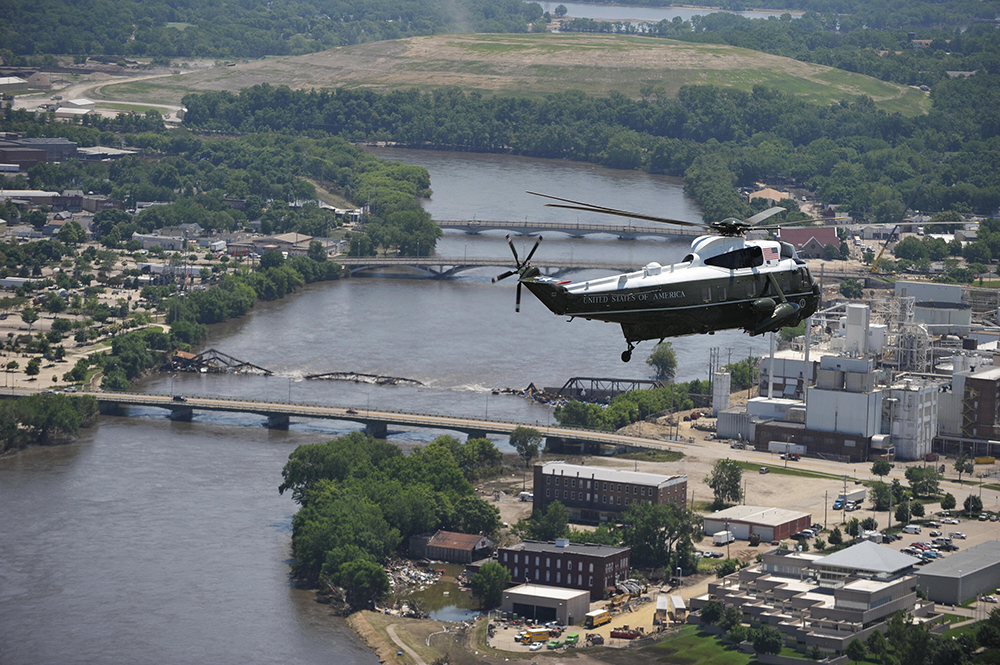
After much of downtown was damaged, community members started rebuilding, but also reimagining what some of their traditional institutions could look like, particularly, school. SourceMedia Group, which runs a newspaper and TV station in Iowa, gathered a group of 60 community leaders and asked them to attend high school classes in Cedar Rapids for a day to see what it was like. The participants found that students were bored, their education wasn’t always connected with the real world, and they were all trying to get good grades rather than learn something because it was interesting.
Pickering, Iowa Big’s co-founder who now leads the school, was an employee of SourceMedia Group at the time and led this rethinking of school with Shawn Cornally, a teacher who also ran a popular education blog around standards-based grading. Originally, the two envisioned opening a summer school based on the community feedback, but the Cedar Rapids school board president heard about the project and asked if the district could take part. A neighboring district joined on as well, opening Iowa BIG for students in the 2013-14 school year.
Right away, Pickering and Cornally stuck to their commitment to make this school different, even starting out at an “extreme,” Pickering said. The school eliminated grades, tests, and curriculum, and followed a standards-based learning approach. Students met these standards by working on multiple projects that they were passionate about with local businesses or nonprofits. Students had freedom about when they showed up to school and when they had to get their work done by.
Iowa BIG’s downtown campus feels more like a startup than a school, even though it’s a little of both. It’s located in a large coworking space, with local businesses using neighboring rooms and floors. There are no desks, but instead a large room with high ceilings and storefront windows overlooking the street. The walls are painted bright blue and green and white boards on wheels stand ready to be rolled around. Some students sit alone on couches working on laptops while others perch around large tables, sometimes joined by a teacher. The teenagers walk in and out of the room without the permission of a bell, some announcing they’re heading back to their high school, others walking out in a group to get coffee.
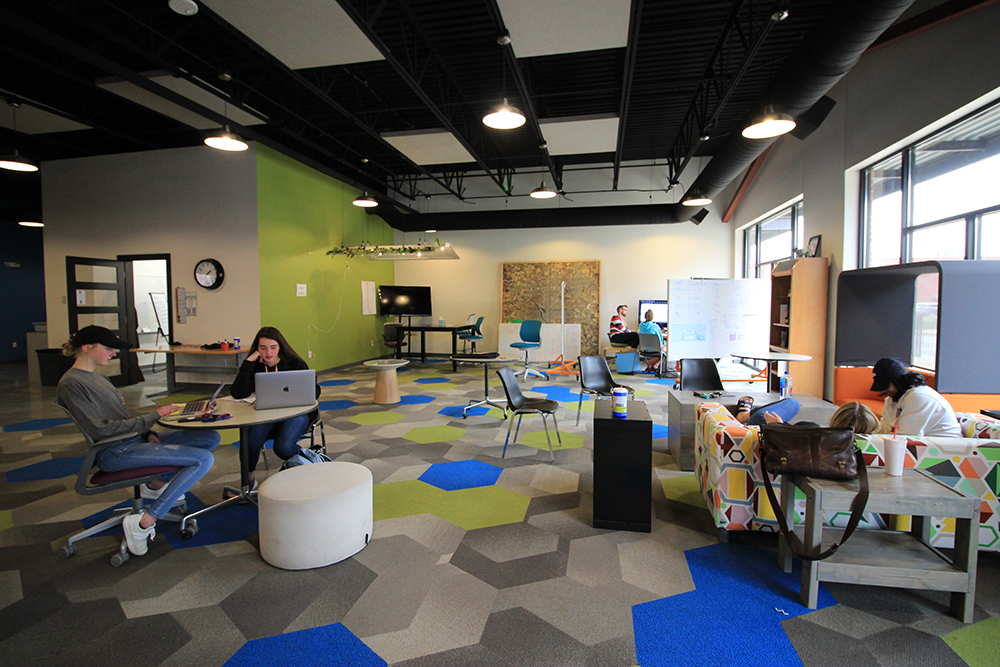
Students readily praised this freedom, but school leaders said not all students are able to handle transitioning to a completely unstructured schedule. This fall, BIG will be adopting two block periods where students from the five public high schools that participate have to attend every day for two hours, at least for the first several weeks. After that, students will slowly earn more freedom about when they have to be on campus, or whether they do their work at home or a local coffee shop. This change also provides more order to the chaos of managing five different high schools’ schedules.
Students don’t receive letter grades at BIG, but rather, indicators of how well they’re meeting standards with marks like “capable” or “transferable.” But when BIG has to send scores back to the students’ traditional high schools, they transfer these marks into letter grades, where capable would be a B and transferrable would be an A.
This type of grading also makes it easier to evaluate soft skills. To do this, BIG uses a tool that looks like a spider web, with traits like productivity, accountability, and creativity scattered around six concentric circles. Four times a year, student and teacher both fill out how well they think the student is demonstrating these skills by shading rings of the web, and then have a conversation about it. While the sixth ring would be the most robust demonstration of these skills, BIG’s goal is to get students to the third ring.
“He doesn’t think he’s accountable at all while the teacher does think he’s accountable,” Pickering said, leaning over his computer screen in his office as he looked at one student’s evaluation. “So this will be an interesting conversation.”
Teachers at BIG said that they worry about making sure their students meet the necessary standards in the span of a school year. The school had to create seminar classes that students could take in addition to their projects because it was hard to learn content like literature or federal government through local business partnerships.
But the teachers also noted how this model gives them more flexibility with how they evaluate students. When teacher Nate Pruett saw one of his students sharing his school project on live TV during an interview with the local media, Pruett was able to give him credit for public speaking, even though the student wasn’t demonstrating this during a test or specific assignment.
There’s a tension that comes from the learning community when schools decide to adopt experiential or project-based models. Students and teachers at Iowa BIG said they’ve heard of other teachers questioning the rigor of Iowa BIG courses because they’re project-based. Research also points to the importance of having a demanding curriculum when it comes to student learning. But Cornally argues that just because a student can regurgitate information on a test doesn’t mean they know how to put it in context.
The work of Iowa BIG is as vast as its name: questioning what students need to know after they graduate.
“(We’re) really challenging the notion that we know what content any kid needs in the future,” Pickering said. “The short answer is, we don’t, outside of basic literacy, knowing how to read, write, communicate well, do basic math, and understand basic science concepts.”
Whether the model works for students is a challenging question. At year six, the best evidence is anecdotal. BIG created a survey for its alumni near the beginning of 2019. Of the 43 students who responded, most went to college, with 62 percent attending a four-year college. A little more than two-thirds said BIG was influential in the path they chose to take after high school graduation. Iowa has the best four-year high school graduation rate in the nation, at 91 percent. Of the five high schools that feed into Iowa BIG, graduation rates range from 85 percent to 96 percent, with four schools surpassing the state average.
The survey also asked students about their relationship to learning and to their communities. When asked whether BIG prepared them to learn in their post-secondary environment, 93 percent either agreed or strongly agreed and 7 percent disagreed. About 32 percent said they are always passionate about what they are working on while 60 percent said they are sometimes passionate. Nearly half said they are always involved in their communities.
“The question, ‘Does this work?’ is impossible,” Cornally said. “We think the way to answer is if the community is involved and supportive … Are students joyful? Efficacious? Do kids know how to fix problems? Or do they lose it as soon as they leave here? We certainly know regular school doesn’t work well. I don’t mean for that to be anti-teacher, I mean for that to be anti-system.”
The ideas behind experiential learning are a century old, but there’s been renewed interest in bringing this model to schools as a method of making learning more relevant to students and preparing them for soft skills that some industry leaders are asking for in their employees. Chris Unger, associate teaching professor at Northeastern University’s Graduate School of Education, co-leads a new institute called NExT, which gathers educators around the country who work in experiential learning models like Iowa BIG to share ideas.
“We talk about kids being able to communicate well, to create, to problem-solve, to collaborate, to do all these things, but how do you learn how to do that if you’re not tasked to do it in a meaningful and authentic way?” Unger said. “Iowa BIG to me is a no-brainer … We don’t need students with just a bunch of book knowledge. We need young men and women who can act in the world.”
Senior Tyler Montgomery, who is in his third year at Iowa BIG, sees the value that both his traditional high school and BIG bring to his learning experience.
“A traditional school does a great job for equipping you with managing homework and being able to sit down and get it done on time for the next day,“ Montgomery said. “BIG also equips them with the ability to manage their time independently when there’s not accountability and manage what needs to be worked on by yourself.”
Learn to fail to learn
On a Wednesday morning before 9 a.m., a group of students in Cedar Rapids were having trouble breathing.
“Oh I’m scared,” said sophomore Carsyn Levi, exhaling deeply and resting her head in her hands.
“I’ve been up since 2 a.m. practicing,” said senior Erin Anderson. “I’m running on fumes.”
The students sitting around them at the table laughed sympathetically, tapping their pens against notebooks. “You’ll feel much better once it’s over,” one said.
“It” was a presentation for 1 Million Cups, a national organization that gathers local entrepreneurs and community members for weekly meetings to share business pitches and solicit feedback. The Iowa Big students sitting around the table were about to share their project with the Cedar Rapids community — a fundraiser for children’s charities — and Levi and Anderson were the two group members tasked with presenting the pitch. While it might sound like a typical high school community service project, the Iowa Big students are responsible for running the show, from marketing and event planning to meeting with the nonprofits they’re funding to engaging the community.
The room they were presenting in was actually in the same building as Iowa BIG, in a co-working multipurpose room. The two students walked to the front and stood on opposite sides of their presentation, clutching echoey microphones. The project they were presenting was part of a fundraising initiative called Pledge4Kids, they explained, and this year, they were holding a fundraiser by hosting a movie night in June. All the money would go toward local children’s nonprofits such as the Boys & Girls Clubs in Cedar Rapids. While they had their location and large movie screen nailed down, they needed help marketing the event.
Pledge4Kids was an organization initially conceived by Paul Phelan, who runs a local business, Phelan Interiors. When Phelan heard that Iowa Big was looking for community projects to work on, he approached the school and offered to let the students lead this project, with his support. Multiple classes of Iowa BIG students have worked on Pledge4Kids, with each group iterating on work past teams had accomplished, from changing the name (Corridor Goes Casual for Kids was too long) to the logo, to how money was raised.
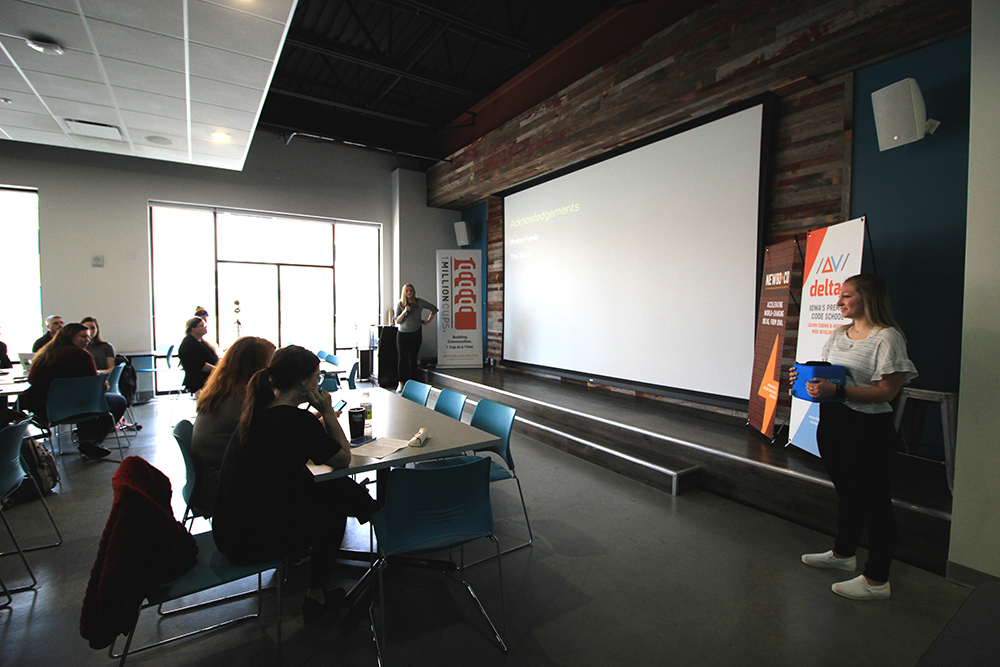
At the end of the presentation, audience hands shot up. Did they consider sending press releases to local radio stations? Did they make sure other events weren’t happening the same day as theirs? What movie were they going to show? How were they going to make sure the event was accessible for people with disabilities?
It was a barrage of questions, but the students fielded each one. Much of the feedback on their pitch came from panelists who were community members involved in development and marketing. At the end of the presentation, one of them, Shannon Hanson, vice president of United Way East Central Iowa, handed the students her business card, with an offer to work with them on any help they might need in figuring out the details of their marketing plan.
“I feel more confident now, that panel was good,” Phelan told the students after the presentation.
But their teachers, who were watching in the audience, wanted to see more.
“In a traditional school setting, it’s a good presentation, but they’re trying to market something,” Pickering said. “It’s all about the journey of getting better.”
At the end of the presentation, the students got feedback from their teachers — they wanted to see more information in the presentation so that there were fewer audience questions.
“We’re planning on taking their feedback to use on future pitches,” Levi said a few weeks later. “This is one of the biggest parts of Iowa BIG — it’s to get actual experience; you live and you learn … Next time we pitch we will all know better what we want to find out first.”
That kind of experience and feedback means that in a few weeks when the students share their pitch with the nonprofits they’re fundraising for, they’ll be more prepared. It’s an opportunity they might not have in a traditional school, Cornally argued, where they could take a test or make a presentation and never get the chance to improve on what they learned.
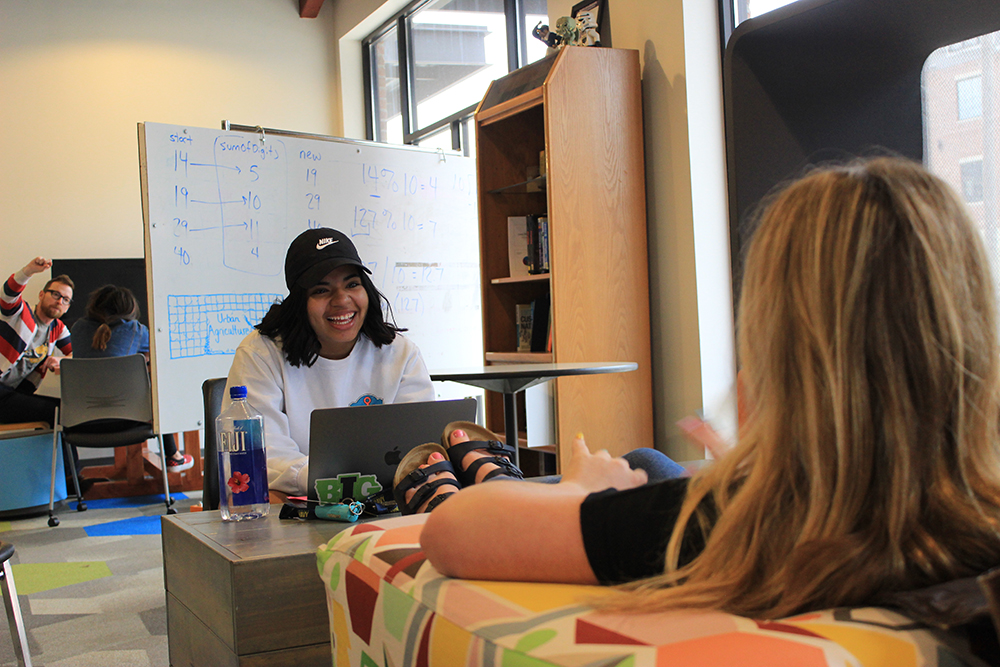
The value of learning from failure is a concept that’s just starting to be studied. At Columbia University, professor of cognitive studies Xiaodong Lin-Siegler leads the Education for Persistence and Innovation Center. In one of her studies from 2016, Lin-Siegler found that student learning improved when students were told about how great scientists like Marie Curie first struggled and failed before they were able to make their renowned discoveries. This was especially true for students who were low performing.
Since the center launched in 2018, Lin-Siegler has received dozens of notes from students across the country asking how her work can be applied to their high school, where the pressure to not fail is overwhelming. Lin-Siegler is currently looking into students’ feelings when encountering failure and how that can inhibit their learning.
“I think that parents and teachers need to be trained and learn how to handle children when they don’t do well, that’s a big part of it,” Lin-Siegler said. “I’m not saying that we should not let kids feel bad. I’m not saying we should not do exams because it harms them or makes them feel bad. The more we gradually bring the reality of life to them, the better we prepare them for the world.”
One of the challenges for teachers at Iowa BIG is figuring out when it’s OK for students to struggle on their own and when they need to step in and assist. For Pruett, he often hopes that students can experience the feeling of messing up so that the learning is more profound.
“We can provide a roadblock or a failure in a pretty safe environment for them,” Pruett said. “Whereas in school, failure is the worst possible thing you can ever encounter because it’s all or nothing in school.”
Montgomery, the senior, remembers one such failure during a project on rockets. A flurry of snow days hit Iowa this past winter, making it hard for the students to meet to work on their projects. Montgomery’s team was tasked with building rockets for a NASA competition. His team failed to communicate properly with the judges about when they could show up to judge their rockets, which meant the team didn’t end up qualifying.
When the group participated in a retrospective meeting with Cornally, they wrote on notecards reasons they thought the project didn’t go according to plan. While the conversation at times got heated, Cornally said, most group members felt good at the end because of the things they learned.
“At the end of the day, it was a failure, but the thing about Iowa BIG is that even in your failures, you learn a lot,” Montgomery said. “I still learned a bunch about managing teams and communicating individually and meeting them where they’re at …With most Iowa BIG projects, even if it’s a failure on paper, the students still learn enough that it was still worth their time.”
Not all students are able to succeed at Iowa BIG — and that’s not dependent on students’ GPAs. Some high-achieving students come in and find the lack of structure frustrating or work on a project they don’t like. On the flipside of that are the students who experienced failure in their traditional public schools and are finally able to experience success at BIG.
Armani Smith-Gibbs is a senior at BIG, and one of a few full-time students the program allows. Smith-Gibbs was on the verge of not graduating last year at her traditional high school. When she heard about BIG, she signed up for her final year, where she worked on projects ranging from supporting middle-schoolers’ sense of identity to working on an exhibit about African-American hair with a local museum.
“At regular school, we learn what we need to graduate, not necessarily what you need in the real world,” Smith-Gibbs said. After graduation, she plans on attending a community college before transfering to a four-year school and studying to be a paralegal or work in real estate.
This kind of learning makes more sense to her, Smith-Gibbs said. At Iowa BIG, she’s not waiting for a clock to tell her when she can leave class or spending time filling out worksheets. She also thrives on the connections she has with her teachers. As she was speaking, Pruett interrupted simply to say good afternoon before walking away.
“I think we’ve changed their lives a little bit in terms of making school interesting again,” said Randy Bauer, board member of College Community School District, one of the first to partner with BIG.
Community as curriculum
Allowing students room to fail requires managing the expectations of the businesses they partner with. Amanda Zhome is one of the strategic partner developers at Iowa BIG who helps find community members interested in working with students. The projects they let the students work on shouldn’t be “mission critical” to the organization, Zhome said.
“We want to be able to turn over a successful, amazing product to the partner, but our goal is the learning,” Zhome said. “And that means we take a lot of detours, we don’t tell students what to do next, we let them try something and then fall and problem solve.”
Sometimes the partners change directions on what they want midway through a project, which can be frustrating for students. But several partners said they are OK with the students shaping the direction of their projects, and let them take the lead.
One such project was about homelessness. Students partnered with a small nonprofit and homeless services provider, Willis Dady, to tell stories of the resiliency of the city’s homeless population. Students spent hours interviewing dozens of people who were experiencing homelessness, and displayed their stories in a gallery in the public library. Emily Zimmon, the employment and outreach programs manager, said the project would not have gotten done without the students.
The students grew “in maturity, in understanding … in the experiences of other people,” Zimmon said.
Zimmon now hears about how these students will see people who they interviewed for the project in Cedar Rapids and stop and say hi to them. One student even decided to study social work in college because of this project.
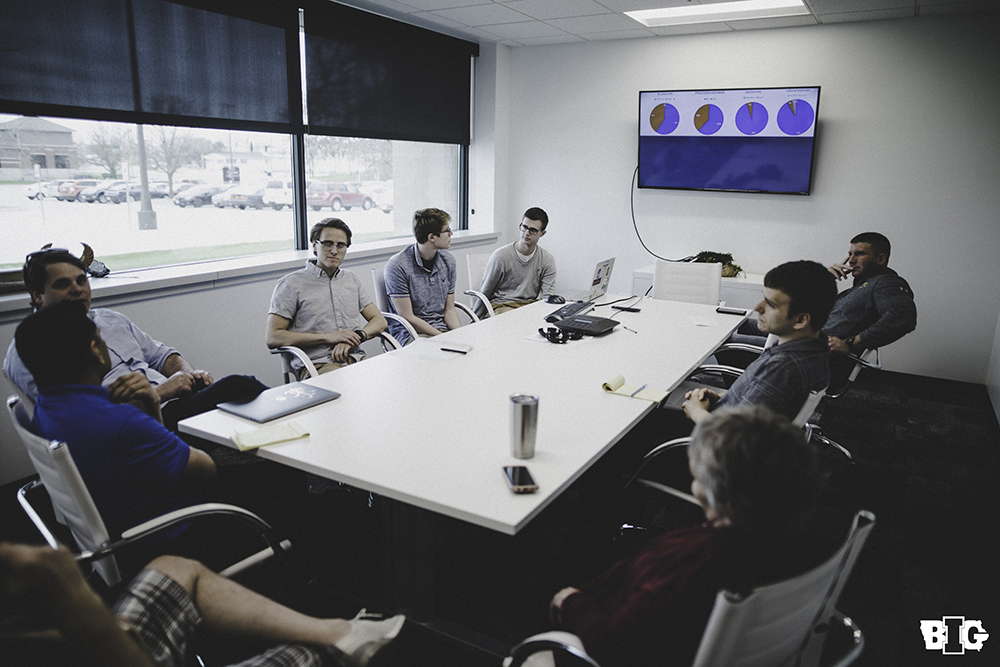
Other students have shared how Iowa BIG helps them figure out what subjects they’re interested in, or which ones they thought they were but actually aren’t. Senior Ivana Ponce had the opportunity to take on projects in both social studies and science, which helped her decide to study chemistry and pre-med at the University of Iowa, where she’ll attend in the fall.
“I think when I was back at the mothership (her traditional high school), I was like, ‘I can’t wait for college,’” Ponce said. “Being at BIG, I can’t wait to be out in the real world and working.”
Many of Iowa BIG’s students who went on to college are facing that real world prospect right now.
Six years after Kinzie Farmer’s famous failure to host a TEDx event in Cedar Rapids, the Iowa BIG alumna finally found herself on a TEDx stage in Spokane, Washington. In those six years, Farmer had moved not just 1,500 miles from home, but has traveled around the world, studied marketing, and landed a job at a startup business in Idaho before graduating college.
Wearing a bright red shirt and looking confidently out at the crowd, Farmer told the audience the story of how her high school experience helped her face fear and led to self-discovery.
“I had both successes and a lot of failure at this school,” Farmer told the audience, “but I was becoming a more pure version of myself … more towards the person I wanted to become.”
Get stories like these delivered straight to your inbox. Sign up for The 74 Newsletter
